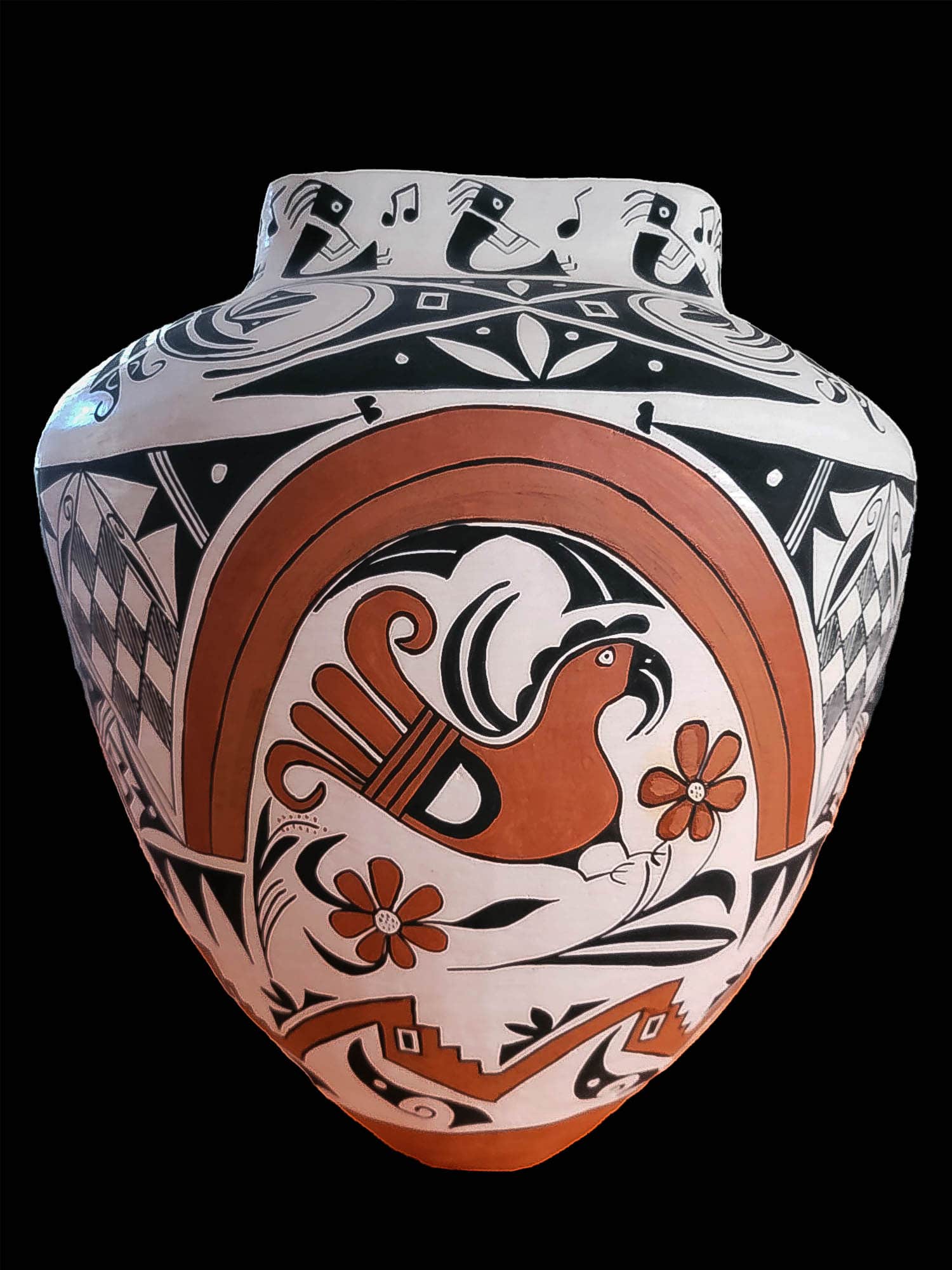Home » Special Exhibits » New Deal Nuevomexicano & Decorative Arts » Objects & Place
New Deal Nuevomexicano and Decorative Arts
Objects & Place
The decorative arts styles championed by New Mexico’s Federal Art Project are fundamentally connected to this place. As explored in the “Reviving ‘Traditions’” section, the Spanish Colonial style revitalized by the New Deal is patently New Mexican in tone, having developed according to specific geographical and environmental circumstances. Nuevomexicano furniture and decorative arts also manifest their distinct cultural context, reflecting the mestizaje, or the Indigenous and European cultural mix, that developed in New Mexico through hybrid motifs.
Look Closely
Look for New Mexican Material Culture
Study the components of this Spanish Colonial chandelier.
What most makes this object look “New Mexican” to you?
Dig Deeper
This kind of tinwork craft is unique to the northern territories of New Spain. Just as hard woods were not readily accessible during the 1600s and 1700s in what is now New Mexico, neither was silver (sixteenth-century Spanish conquistadors never fulfilled their quest to locate the area’s rumored “Seven Cities of Gold”). As a substitute for silver, tin was hammered and punched—a technique also known as repoussé and chasing—to create utilitarian, decorative, and religious objects, such as crosses, nichos, and other items of special significance. Prior to the opening of the Santa Fe Trail in 1821, tin was relatively rare. After 1821, however, tin became much more widely available both in the form of sheets of tinplate and also in the form of recyclable objects, and tinwork became a hugely popular art form. For instance, Hispano tinsmiths frequently upcycled (to use current terminology) multi-gallon lard and lamp oil containers discarded by American settlers and the U.S. Army into frames and light fixtures. Tinwork became so ubiquitous that, despite it being a largely post-1821 tradition, the state’s Federal Art Project latched on to it as an inherently and uniquely Nuevomexicano art form, promoting it through vocational schools and workshops.
Look Again: Tinwork Light
This light fixture appears to be modeled after an example provided in the state’s “Tin Craft in New Mexico” bulletin (published in 1937, and researched by Carmen Espinoza, one of the only Hispano consultants engaged in the New Deal effort to revive Spanish Colonial arts). It augments the pattern’s use of essential Spanish Colonial characteristics such as rosettes and scalloped edges.
 Drawing by Carmen G. Espinosa from the original by Truman J. Mathews, architect. From Sewell, Brice H. and New Mexico State Board for Vocational Education. 1937. Tin Craft in New Mexico. Santa Fe N.M: New Mexico State Dept. of Vocational Education Dept. of Trades & Industries. Image courtesy of Bartlett Library and Archives, Museum of International Folk Art.
Drawing by Carmen G. Espinosa from the original by Truman J. Mathews, architect. From Sewell, Brice H. and New Mexico State Board for Vocational Education. 1937. Tin Craft in New Mexico. Santa Fe N.M: New Mexico State Dept. of Vocational Education Dept. of Trades & Industries. Image courtesy of Bartlett Library and Archives, Museum of International Folk Art.
This light fixture also elaborates on the pattern, adding mestizaje elements not in the pattern: parrot and rainbow motifs that appear in Spanish Colonial design and also in Pueblo pottery.
 City of Gallup Historical Collection, Elizabeth Andron Houser Collection, #1156.
City of Gallup Historical Collection, Elizabeth Andron Houser Collection, #1156.
Jessie Garcia (Acoma)
Pot
About 1970s
7½” H x 11″ D
 Gallup Cultural Center Collection; image courtesy of the Gallup Cultural Center.
Gallup Cultural Center Collection; image courtesy of the Gallup Cultural Center.
D. Estevan and L. Torivio (Acoma)
Rainbird Pot
Undated
7½” H x 11″ D
Look Again: Trastero
Mestizaje is exactly the right word to describe this trastero and its combination of elements. The top panels of its doors are embellished with stylized corn designs that play off the lines and curves of the scallops and rosettes below. The doors are complemented by side panels carved with elegant squash blossom motifs. The bringing together of Spanish Colonial forms and patterns with imagery of crops indigenous to the Americas gives this trastero a characteristically New Mexican look.

Click to view educator Laura Jijon’s Guest-Curated Tour
Eliseo Rodriguez
Quenching Their Thirst is an expression of a world view, communicating the interweaving of spiritual life with daily life in Nuevomexicano communities.
On one level, the painting depicts a campesino laborer, sporting a sombrero and handlebar mustache, taking a water break. This would not have been an unfamiliar scene to New Mexicans prior to and during the New Deal era.
On another level, as Laura Jijon details in her Guest-Curated Tour, this painting may be read as an allegory for the gospel story of Jesus and the woman at the well. New Mexicans have a history of relating their lived experiences on the frontier to biblical narratives. Rodriguez, a devoutly spiritual person, gives visual form to this practice and, in doing so, reveals the depth of meaning that permeates Nuevomexicanos’ labor, relationships, and existence. As Tey Marianna Nunn notes, though Rodriguez’s subject matter ranged from still lifes of Mexican ceramics and fruit to views of churches to landscapes to Bible scenes, “his works emote an artistic and spiritual religiosity that transcends time and place.”8
Quenching Their Thirst reminds us that cultural production and perpetuation is not a matter of criteria or checklists. It cannot be reduced to formulaic principles. Rather, it is a matter of active participation and meaningful human connection.









